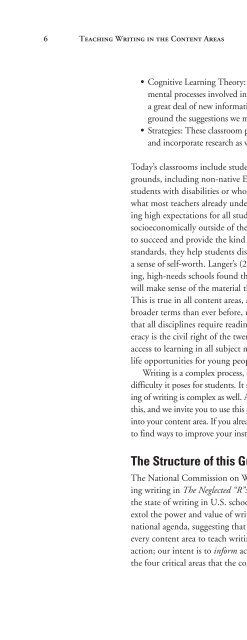How to Use It - ymerleksi - home
How to Use It - ymerleksi - home
How to Use It - ymerleksi - home
Create successful ePaper yourself
Turn your PDF publications into a flip-book with our unique Google optimized e-Paper software.
6 Teaching Writing in the Content Areas• Cognitive Learning Theory: Educa<strong>to</strong>rs know more than before about themental processes involved in learning. Cognitive psychologists have compileda great deal of new information about thinking and learning. These theoriesground the suggestions we make regarding writing instruction.• Strategies: These classroom practices and methods work in any content areaand incorporate research as well as theory (see Section 5).Today’s classrooms include students from many different ethnic and racial backgrounds,including non-native English speakers who are struggling <strong>to</strong> learn andstudents with disabilities or who need extra help with reading. Research supportswhat most teachers already understand—the power of having and communicatinghigh expectations for all students, including those who are ethnically orsocioeconomically outside of the mainstream. When teachers expect all students<strong>to</strong> succeed and provide the kind of instruction that will help them meet highstandards, they help students dispel a fear of writing, gain confidence, and builda sense of self-worth. Langer’s (2000) research in<strong>to</strong> the success of high-performing,high-needs schools found that when students are treated as if they can andwill make sense of the material they read and write, they are more successful.This is true in all content areas, and educa<strong>to</strong>r-researchers now view literacy inbroader terms than ever before, using the term “disciplinary literacy” <strong>to</strong> signifythat all disciplines require reading, writing, and thinking skills: “Disciplinary literacyis the civil right of the twenty-first century. Disciplinary literacy providesaccess <strong>to</strong> learning in all subject matters and, by so doing, opens up an array oflife opportunities for young people” (Lee, 2004).Writing is a complex process, and most of the research literature recognizes thedifficulty it poses for students. <strong>It</strong> seems reasonable <strong>to</strong> expect, then, that the teachingof writing is complex as well. As teachers, researchers, and writers, we recognizethis, and we invite you <strong>to</strong> use this guidebook <strong>to</strong> help you integrate writing instructionin<strong>to</strong> your content area. If you already are a language arts instruc<strong>to</strong>r, we challenge you<strong>to</strong> find ways <strong>to</strong> improve your instruction and share your discoveries with others.The Structure of this GuidebookThe National Commission on Writing (2003) addresses the challenge of teachingwriting in The Neglected “R”: The Need for a Writing Revolution, a report onthe state of writing in U.S. schools in which the nation’s educa<strong>to</strong>rs and writersex<strong>to</strong>l the power and value of writing. Furthermore, the commission calls for anational agenda, suggesting that nothing short of a revolution will get teachers inevery content area <strong>to</strong> teach writing. Their intent is <strong>to</strong> stir schools and teachers <strong>to</strong>action; our intent is <strong>to</strong> inform action with research. <strong>How</strong>ever, we do agree withthe four critical areas that the commission identifies as framing the issue of
















